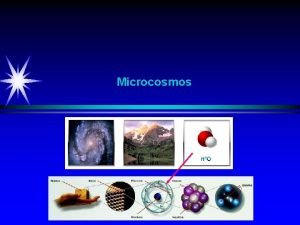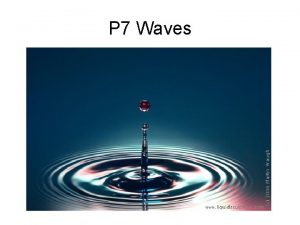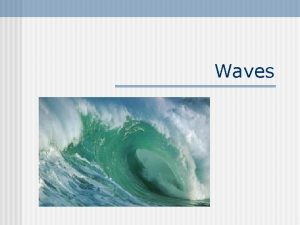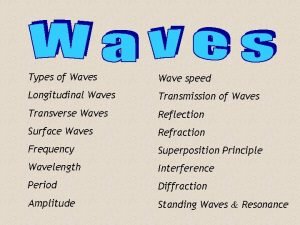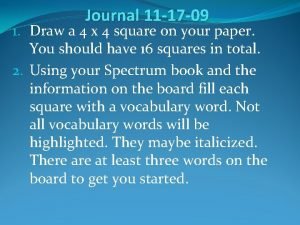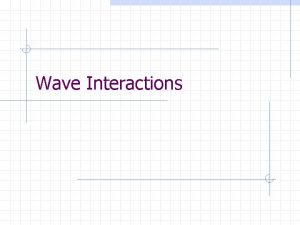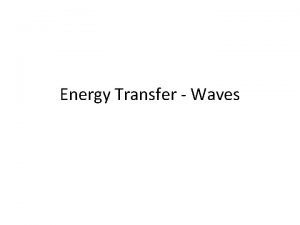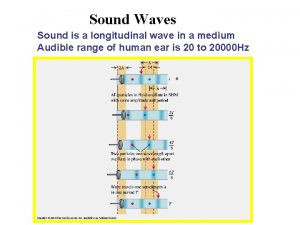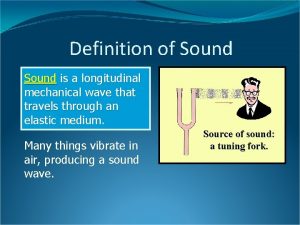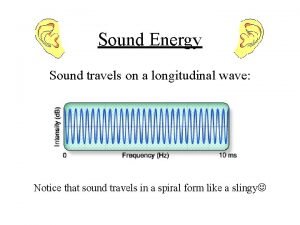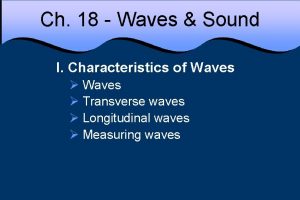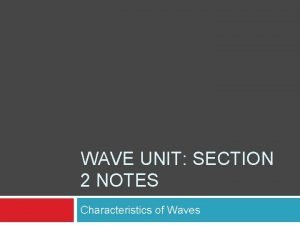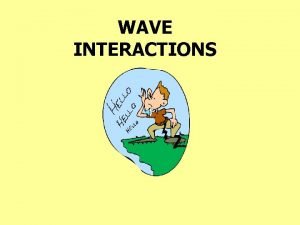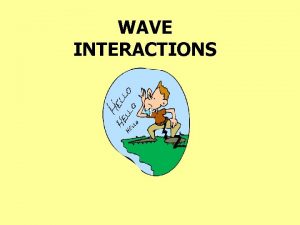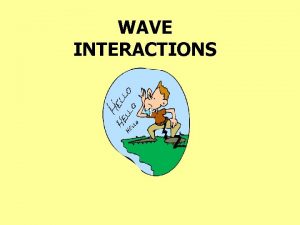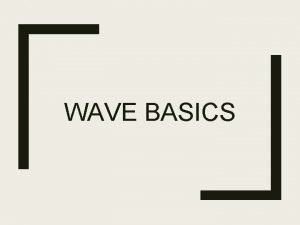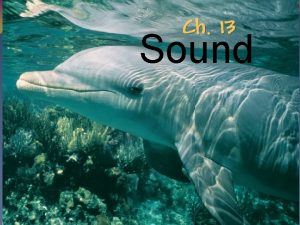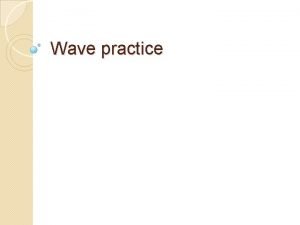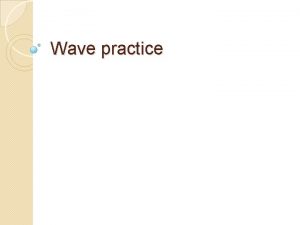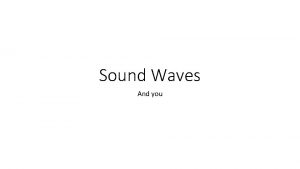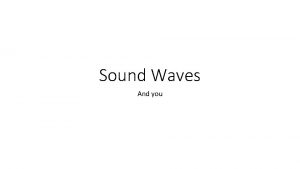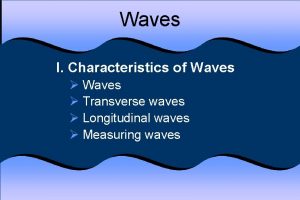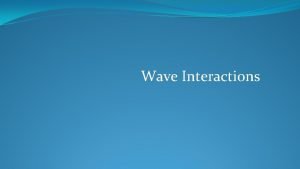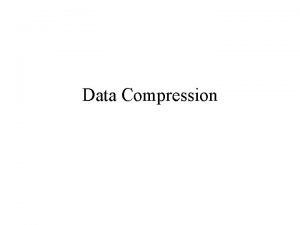WAVE INTERACTIONS Longitudinal Wave Compression Waves wave particles
































- Slides: 32

WAVE INTERACTIONS

Longitudinal Wave (Compression Waves) wave particles vibrate back and forth along the path that the wave travels. *sound

• Compressions The close together part of the wave • Rarefactions The spread-out parts of a wave

Transverse waves wave particles vibrate in an up-and-down motion.

Waves transfer energy without transferring matter. Frequency= waves/time

Parts of a wave • • Crest Trough Wavelength Amplitude

Amplitudeis the maximum distance the particles in a wave vibrate from their rest positions. Frequency - the number of waves produced in a given time

Wave Velocity - is the speed with which a wave crest passes by a particular point in space It is measured in meters/second. Wave Velocity = Frequency Wavelength

Speed of Sound • Medium air (20 C) air (0 C) water (25 C) sea water diamond iron copper glass velocity m/sec 343 331 1493 1533 12000 5130 3560 5640

Waves Practice 20. 1 II. Properties of Sound


Let’s Review: 1. ) What is the number of vibrations per second? 2. ) What is the distance between two points on a wave where the wave pattern is repeated? 3. ) The speed of a mechanical wave depends on _______? 4. ) The time needed for a wave to make one complete cycle is called _________? 5. ) Sound is an example of a _______ wave. 6. ) Sound waves cannot travel through __________.

Speed of Sound • The speed of sound is determined by the temperature , elasticity , and density of the medium through which the sound travels

Pitch - description of how low or high the sound seems to a person *determined by wavelength *low pitch sounds have low frequencies (fog horn or thunder) *High pitch sounds have high frequencies (kids screaming on the playground, mouse squeak) Loudness- how loud or soft a sound is perceived to be *amplitude determines how loud a sound is *wavelength does not change

Loudness of Sound in Decibels Sound Loudness (dbs) Hearing Damage Average Home 40 -50 Loud Music 90 -100 After long exposure Rock Concert 115 -120 Progressive Jet Engine 120 -170 Pain

Constructive Interference-when waves meet crest to crest or trough to trough, an additive effect. Destructive Interference- when the crest of one wave fills in the trough of another wave, a canceling effect.

Standing Waves Standing Wave – wave where certain parts of the wave remain stationary due to interference. Nodes- stationary parts of a standing wave Antinodes- positions on a standing wave with the largest amplitudes. They occur halfway between the nodes.

Harmonics • A type of standing wave produced when destructive interference produces a point with no movement and constructive interference produces a point with maximum displacement.

A E N T I N O D E A E N T I N O D E N O D E A E N T I N O D E Harmonics N O D E A E N T I N O D E


Standing sine wave patterns of air vibrating in an open tube. Note that both ends have anitnodes.

Standing waves in these open tubes have an antinode at the open end, where air is free to vibrate.

Standing Waves 20. 1 Practice Standing Waves Demo

Resonance Forced Vibration- vibration of an object that is made to vibrate by another vibrating object that is nearby. Ex. Tuning forks Natural Frequency – frequency of vibrations of elastic objects that create their own special sound. Ex. Bells and Tuning forks Resonance – when a forced vibration matches the objects natural frequency. Ex. Swing

Check it out. . . • https: //youtu. be/jo. S 6 kfju. KQo • https: //youtu. be/u. ENITui 5_j. U • https: //youtu. be/2 awb. KQ 2 DLRE • https: //youtu. be/Q 3 o. Itp. Va 9 fs

Doppler Effect- change in frequency due to the motion of the source or observer. The greater the speed of the source (or observer) the greater the Doppler Effect. Example: Fire Engine, Ambulance, Train

• Named after the Austrian scientist Christian Doppler • He was studying the color or stars in binary systems (two stars that are close together) • Figured out that their movement was related to color • Discovered REDSHIFT (on the em spectrum) (redshift is the most convincing evidence for the Big Bang, but the Big Bang hadn’t been though of yet!)

• http: //youtu. be/h 4 On. BYrb. Cj. Y • https: //youtu. be/kdi. Hm. SWI 2 Ks

If the source is moving as fast or faster than the speed of sound, the sound waves pile up into a shock wave called a sonic boom. n A sonic boom sounds very much like the pressure wave from an explosion n

Supersonic Flight

If the source is moving as fast or faster than the speed of sound, the sound waves pile up into a shock wave called a sonic boom. A sonic boom sounds very much like the pressure wave from an explosion

Formula and worksheet
 Sound waves longitudinal waves
Sound waves longitudinal waves Electromagnetic waves are transverse waves true or false
Electromagnetic waves are transverse waves true or false Fundamental particles and interactions
Fundamental particles and interactions Compare and contrast transverse and longitudinal waves
Compare and contrast transverse and longitudinal waves Transverse wave and longitudinal wave example
Transverse wave and longitudinal wave example Draw and label transverse wave
Draw and label transverse wave Rarefaction of a wave
Rarefaction of a wave Transverse vs longitudinal waves
Transverse vs longitudinal waves List of waves
List of waves Longitudinal and transverse waves
Longitudinal and transverse waves Wave interactions
Wave interactions Wave
Wave The maximum distance a wave varies from its rest position
The maximum distance a wave varies from its rest position Low amplitude wave
Low amplitude wave Transverse wave energy transfer
Transverse wave energy transfer Speed of sound in fresh water
Speed of sound in fresh water Mechanical wave definition
Mechanical wave definition Longitudinal wave
Longitudinal wave Characteristics of a longitudinal wave
Characteristics of a longitudinal wave A physics teacher attaches a slinky to the wall
A physics teacher attaches a slinky to the wall Nature of sound wave
Nature of sound wave Characteristics of a longitudinal wave
Characteristics of a longitudinal wave Wave unit
Wave unit Differences between mechanical and electromagnetic waves
Differences between mechanical and electromagnetic waves Mechanical waves and electromagnetic waves similarities
Mechanical waves and electromagnetic waves similarities Compare and contrast p waves and s waves using venn diagram
Compare and contrast p waves and s waves using venn diagram Long waves and short waves
Long waves and short waves Electromagnetic and mechanical waves
Electromagnetic and mechanical waves Surface waves and body waves
Surface waves and body waves Difference between matter waves and electromagnetic waves
Difference between matter waves and electromagnetic waves Constructive
Constructive Mechanical wave and electromagnetic wave
Mechanical wave and electromagnetic wave Examples of mechanical and electromagnetic waves
Examples of mechanical and electromagnetic waves


